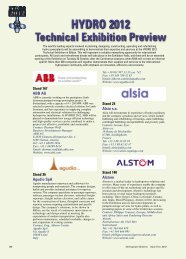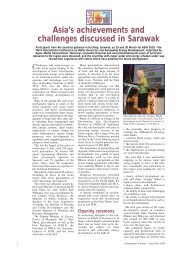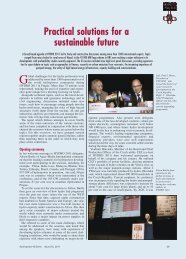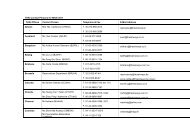Inga project PDF - International Journal on Hydropower and Dams
Inga project PDF - International Journal on Hydropower and Dams
Inga project PDF - International Journal on Hydropower and Dams
- No tags were found...
Create successful ePaper yourself
Turn your PDF publications into a flip-book with our unique Google optimized e-Paper software.
Recent <str<strong>on</strong>g>Inga</str<strong>on</strong>g> studies offer new hopefor Africa’s energy securityA high level panel discussi<strong>on</strong> took place during HYDRO 2011 in Prague based <strong>on</strong> the recently completed <strong>and</strong> approvedprefeasibility studies for the <str<strong>on</strong>g>Inga</str<strong>on</strong>g> development in DRC. Various design opti<strong>on</strong>s were presented for the staged development of ascheme which could eventually provide up to 42 000 MW of capacity for the African c<strong>on</strong>tinent, including ec<strong>on</strong>omic <strong>and</strong> technicalaspects. The scheme will involve four ‘energy highways’ to transmit power to large areas of eastern, western <strong>and</strong> southern Africa, aswell as meeting the rapidly increasing domestic <strong>and</strong> industrial energy requirements of DRC. The sessi<strong>on</strong> ended with the TechnicalAdvisor to DRC’s Ministry of Energy inviting investors, either public or private, to participate in “this major <str<strong>on</strong>g>project</str<strong>on</strong>g> of the century”.Within a full-day track of sessi<strong>on</strong>s focusing <strong>on</strong>Africa during HYDRO 2011 in Prague, <strong>on</strong>eof the important highlights, <strong>on</strong> the morningof 18 October, was a panel discussi<strong>on</strong> entitled ‘<str<strong>on</strong>g>Inga</str<strong>on</strong>g>,the Potential Powerhouse of Africa’. This took placejust a few days after a major milest<strong>on</strong>e in the developmentof the scheme, when recently completed prefeasibilitystudies, c<strong>on</strong>ducted by a partnership of AECOM(Canada) <strong>and</strong> EDF (France) had been reviewed <strong>and</strong>approved in Kinshasa.The sessi<strong>on</strong> was chaired by ICOLD Secretary-General, Michel de Vivo. Panellists were AlbertMbafumoya-Tchomba, Technical Advisor to theMinistry of Energy of DRC, Stéphane St Pierre, VicePresident of Hydro Africa at AECOM, Pierre Lorillou,Deputy Project Manager for <str<strong>on</strong>g>Inga</str<strong>on</strong>g> at EDF, ArnaudRousselin, Civil Works Project Engineer at EDF,Rheaume Veilleux, Project Manager for EnergyTransmissi<strong>on</strong> <strong>and</strong> Distributi<strong>on</strong> at AECOM, <strong>and</strong>François Lempérière, Director of Hydro Coop(France) who has provided technical support for the<str<strong>on</strong>g>Inga</str<strong>on</strong>g> studies for EDF.De Vivo, in his opening remarks, described <str<strong>on</strong>g>Inga</str<strong>on</strong>g> as“the African dream”, which has provided so muchhope for the c<strong>on</strong>tinent. This <str<strong>on</strong>g>project</str<strong>on</strong>g>, he c<strong>on</strong>tinued,which had been studied <strong>and</strong> discussed for at least 50years, would eventually be able to supply more than40 000 MW (making it much larger than ThreeGorges), <strong>and</strong> would be able to supply nati<strong>on</strong>s as geographicallydistant as Egypt in the north, <strong>and</strong> SouthAfrica in the south. About 500 milli<strong>on</strong> households inAfrica could be supplied with electricity, he said. Henoted that a number of problems had blocked the <str<strong>on</strong>g>project</str<strong>on</strong>g>in the past, including the cost, the l<strong>on</strong>g powertransmissi<strong>on</strong> lines which would be involved, somepolitical problems, the uncertainty about power offtakers,<strong>and</strong> financial instituti<strong>on</strong>s which were formerly notalways ready to support hydro.In the 1970s <strong>and</strong> 1980s, first steps for the developmentof <str<strong>on</strong>g>Inga</str<strong>on</strong>g>’s potential had been taken, with the c<strong>on</strong>structi<strong>on</strong>of <str<strong>on</strong>g>Inga</str<strong>on</strong>g> I <strong>and</strong> II, but today <strong>on</strong>ly about 40 percent of their capacity was available, because of someoperati<strong>on</strong>al <strong>and</strong> maintenance issues (now beingaddressed with a World Bank-funded refurbishmentscheme).The discussi<strong>on</strong>s of the panel, De Vivo said, wouldfocus <strong>on</strong> the parallel studies under way for <str<strong>on</strong>g>Inga</str<strong>on</strong>g> 3 <strong>and</strong>for the staged development of Gr<strong>and</strong> <str<strong>on</strong>g>Inga</str<strong>on</strong>g>.DRC’s electricity sector <strong>and</strong> the futurerole of <str<strong>on</strong>g>Inga</str<strong>on</strong>g>A. Mbafumoya-Tchomba began discussi<strong>on</strong>s by givingdelegates an outline of the electricity sector in hiscountry, <strong>and</strong> a brief overview of the plans for <str<strong>on</strong>g>Inga</str<strong>on</strong>g>. Thecountry’s hydro potential totals 100 GW, he said, with44 GW at the <str<strong>on</strong>g>Inga</str<strong>on</strong>g> site. The present electrificati<strong>on</strong> rate,however, was <strong>on</strong>ly 9 per cent (or 6.5 milli<strong>on</strong> of thepopulati<strong>on</strong> of 72 milli<strong>on</strong>).Another c<strong>on</strong>straint for the sector was that <strong>on</strong>ly 1200MW of the total capacity of 2500 MW at <str<strong>on</strong>g>Inga</str<strong>on</strong>g> I <strong>and</strong> IIwas currently available, because of obsolete equipment<strong>and</strong> a lack of adequate maintenance. A powerdeficit of at least 1000 MW could be expected by2015, he c<strong>on</strong>tinued, based <strong>on</strong> public requirements <strong>and</strong>industrial dem<strong>and</strong> from the mining company Katanga.The country had also historically suffered from a lackof financial resources <strong>and</strong> limited capacity to mobilize<strong>and</strong> manage large amounts of funding, as well as inadequateinstituti<strong>on</strong>al <strong>and</strong> legal frameworks.Mbafumoya-Tchomba commented that electricitysector reform was now planned, including the introducti<strong>on</strong>of an Electricity By-law, which was currentlyunder review by Parliament, <strong>and</strong> was to be enacted bythe President shortly. Other imminent innovati<strong>on</strong>swere the appointment of a Independent Energy Board,to oversee operators <strong>and</strong> to arbitrate between operatorsAbove left: AlbertMbafumoya-Tchomba,Technical Advisor tothe Ministry ofEnergy, DRC. Heinvited potentialinvestors to “becomeinvolved in the <str<strong>on</strong>g>project</str<strong>on</strong>g>of the century”.Above: ICOLDSecretaary-GeneralMichel de Vivo, whochaired the sessi<strong>on</strong> <strong>on</strong><str<strong>on</strong>g>Inga</str<strong>on</strong>g>.Photo left: Generalview of the panel.<strong>Hydropower</strong> & <strong>Dams</strong> Issue Six, 2011 1
Pierre Lorillou ofEDF, who focused inhis talk <strong>on</strong> the futurepower dem<strong>and</strong> ofDRC, <strong>and</strong> of thevarious Africanpower pools towhich power couldbe exported from<str<strong>on</strong>g>Inga</str<strong>on</strong>g>.<strong>and</strong> c<strong>on</strong>sumers, <strong>and</strong> a new legal framework for powerassets.<str<strong>on</strong>g>Inga</str<strong>on</strong>g> 3 c<strong>on</strong>structi<strong>on</strong>Mbafumoya-Tchomba then reviewed progress <strong>on</strong> <str<strong>on</strong>g>Inga</str<strong>on</strong>g>3, which was to be developed as a public-private partnership(PPP). Following a call for expressi<strong>on</strong>s ofinterest in 2010, six groups had been pre-selected inApril 2011. An MoU about the <str<strong>on</strong>g>project</str<strong>on</strong>g> was sent tothem in May, requesting proposals based <strong>on</strong> a designof the scheme involving tunnels as the water c<strong>on</strong>veyancesystem; in August, an addendum was sent tothe potential developers c<strong>on</strong>cerning an alternativesoluti<strong>on</strong>, involving an open channel. Proposals werereceived from three pre-selected groups in August, <strong>and</strong><strong>on</strong> 10 October a legal counsel was appointed to advisethe DRC Government (GDRC) in the selecti<strong>on</strong> of thedeveloper, with support from the African DevelopmentBank. Proposals had been reviewed in a public meeting<strong>on</strong> 15 October.The next steps would be to select the developer,based also <strong>on</strong> the advice of an expert commissi<strong>on</strong> fromthe African Uni<strong>on</strong> Commissi<strong>on</strong>, <strong>and</strong> to negotiate anagreement. An aut<strong>on</strong>omous company would then becreated, which would be called <str<strong>on</strong>g>Inga</str<strong>on</strong>g> 3 ProjectDevelopment Company; the selected developer is tobe a majority shareholder, <strong>and</strong> the company wouldalso include other investors <strong>and</strong> GDRC.Technical, financial <strong>and</strong> legal support was expectedfrom internati<strong>on</strong>al financing instituti<strong>on</strong>s, <strong>and</strong> agreementswould be made with potential power purchases,<strong>on</strong>e of which is to be BHP Billit<strong>on</strong>.Gr<strong>and</strong> <str<strong>on</strong>g>Inga</str<strong>on</strong>g>Mbafumoya-Tchomba explained that GDRC was alsofirmly committed to the development of Gr<strong>and</strong> <str<strong>on</strong>g>Inga</str<strong>on</strong>g>,<strong>and</strong> was c<strong>on</strong>fident that this could be implemented inparallel. This major <str<strong>on</strong>g>project</str<strong>on</strong>g> is also to be developed asa PPP, with an eventual planned capacity of at least39 000 MW.Studies to c<strong>on</strong>firm the optimal development of theavailable potential at <str<strong>on</strong>g>Inga</str<strong>on</strong>g> were being financed by theAfrican Development Bank, at a cost of US$14.5 milli<strong>on</strong>.A c<strong>on</strong>tract had been signed with AECOM (RSW)of Canada with EDF (France) in December 2010 forthe following services:• preliminary study of dem<strong>and</strong> <strong>and</strong> producti<strong>on</strong> capacity;• prefeasibility study of Gr<strong>and</strong> <str<strong>on</strong>g>Inga</str<strong>on</strong>g>;• envir<strong>on</strong>mental <strong>and</strong> social impact studies; <strong>and</strong>,• preparati<strong>on</strong> of an intermediate report <strong>on</strong> <str<strong>on</strong>g>project</str<strong>on</strong>g>structuring <strong>and</strong> financing.At a meeting in Kinshasa between 12 <strong>and</strong> 14 October2011, the report was approved by DRC’s Ministry ofEnergy.The panel validated, in October, the open channelopti<strong>on</strong> for the scheme, without river closure, as thefirst developmental phase of Gr<strong>and</strong> <str<strong>on</strong>g>Inga</str<strong>on</strong>g>.Mbafumoya-Tchomba c<strong>on</strong>cluded that, as well as providingclean, abundant, reliable <strong>and</strong> cheap energy toboost development in DRC <strong>and</strong> throughout Africa, thescheme would help to reduce the impacts of climatechange, reduce poverty <strong>and</strong> reinforce regi<strong>on</strong>al ec<strong>on</strong>omicdevelopment.Staged development of Gr<strong>and</strong> <str<strong>on</strong>g>Inga</str<strong>on</strong>g>A joint presentati<strong>on</strong> was then given by P. Lorillou(EDF) <strong>and</strong> S. St Pierre (AECOM).Lorillou explained that the terms of reference of theC<strong>on</strong>sortium had been to propose an optimal strategyfor developing the <str<strong>on</strong>g>Inga</str<strong>on</strong>g> site, to analyse the availableexisting studies <strong>on</strong> <str<strong>on</strong>g>Inga</str<strong>on</strong>g> 3 <strong>and</strong> Gr<strong>and</strong> <str<strong>on</strong>g>Inga</str<strong>on</strong>g>, <strong>and</strong> to compare<str<strong>on</strong>g>Inga</str<strong>on</strong>g> 3, Gr<strong>and</strong> <str<strong>on</strong>g>Inga</str<strong>on</strong>g> <strong>and</strong> a regi<strong>on</strong>al <str<strong>on</strong>g>project</str<strong>on</strong>g> (BekoAbo). The studies will eventually lead to the compilati<strong>on</strong>of six volumes:• Supply <strong>and</strong> Dem<strong>and</strong> Study• Prefeasibility Study• Feasibility Study• Envir<strong>on</strong>mental <strong>and</strong> Social Impact Study• Structuring <strong>and</strong> Financing Study• Communicati<strong>on</strong> <strong>and</strong> Public Awareness.He underlined the broad range of topics covered bythe study. The present talk, he said, would focus <strong>on</strong> thework already completed (<strong>on</strong> supply <strong>and</strong> dem<strong>and</strong>, <strong>and</strong>the prefeasibility report).Regarding the market for power from <str<strong>on</strong>g>Inga</str<strong>on</strong>g>, he saidthis fell into three categories:• industrial dem<strong>and</strong> (a major customer being BHPBillit<strong>on</strong>, producing aluminium, <strong>and</strong> the Katanga miningcompany);• commitment for high voltage exports; <strong>and</strong>,• public dem<strong>and</strong> (domestic) for which there werethree scenarios depending <strong>on</strong> development of thenati<strong>on</strong>al grid.Taking into account also the <str<strong>on</strong>g>project</str<strong>on</strong>g>ed populati<strong>on</strong>increase <strong>and</strong> future industrial dem<strong>and</strong>, Lorillou saidthat the total increase in dem<strong>and</strong> forecast by 2030 was6000 MW.Some power producti<strong>on</strong> increases would be madepossible by the rehabilitati<strong>on</strong> of <str<strong>on</strong>g>Inga</str<strong>on</strong>g> I <strong>and</strong> II, but nevertheless,according to the power balance analysis,dem<strong>and</strong> to be covered by the new <str<strong>on</strong>g>Inga</str<strong>on</strong>g> developmentwould be around 1500 MW by 2020 <strong>and</strong> about 3000MW by 2030.Turning to the possibilities for future major powerc<strong>on</strong>sumers, Lorillou explained that the studies hadtaken into account the power pools of western, eastern<strong>and</strong> southern Africa (encompassing some countrieslikely to be major c<strong>on</strong>sumers, such as Nigeria, Egypt<strong>and</strong> South Africa (these three representing nearly 80per cent of the dem<strong>and</strong> within their respective powerpools). The hypothesis (based <strong>on</strong> experience of themajor c<strong>on</strong>sumers in the regi<strong>on</strong>, <strong>and</strong> other countriesworldwide) was that countries would be ready to takeabout 5 per cent of their dem<strong>and</strong> from a single <str<strong>on</strong>g>project</str<strong>on</strong>g>outside their own country. If c<strong>on</strong>fidence was then created,this could possibly increase to 10 per cent.Looking at <str<strong>on</strong>g>project</str<strong>on</strong>g>ed dem<strong>and</strong> of the three major c<strong>on</strong>-2 <strong>Hydropower</strong> & <strong>Dams</strong> Issue Six, 2011
sumers, <strong>and</strong> applying the 5 per cent hypothesis, it wasestimated that 3500 MW would be c<strong>on</strong>sumed byEgypt, the same amount by South Africa, <strong>and</strong> 1300MW by Nigeria.Adding to this the internal dem<strong>and</strong> of DRC <strong>and</strong> therequirements of BHP Billit<strong>on</strong> (totalling 3000 MW by2020) it was clear that the dem<strong>and</strong> for <str<strong>on</strong>g>Inga</str<strong>on</strong>g> was there,Lorillou said, with at least 5000 MW being required by2030 (1500 MW for DRC <strong>and</strong> 3500-5000 MW forexport).It was expected, he added, that <strong>on</strong>ce the first “internati<strong>on</strong>alstep” had been taken, then the c<strong>on</strong>fidencewould increase am<strong>on</strong>g other investors, <strong>and</strong> dem<strong>and</strong>from <str<strong>on</strong>g>Inga</str<strong>on</strong>g> would increase.Lorillou c<strong>on</strong>cluded his part of the talk by recallingthat the current studies were looking at the <str<strong>on</strong>g>Inga</str<strong>on</strong>g> site asa whole, with an integrated view of <str<strong>on</strong>g>Inga</str<strong>on</strong>g> 3 <strong>and</strong> Gr<strong>and</strong><str<strong>on</strong>g>Inga</str<strong>on</strong>g>, <strong>and</strong> the aim was to find optimal soluti<strong>on</strong>s forboth DRC <strong>and</strong> the offtakers.Previous studies had led to soluti<strong>on</strong>s which wouldhave involved very high initial investments in civilworks, so the present studies were focusing <strong>on</strong> a stageddevelopment, to reduce the costs at the outset. Theemphasis was also <strong>on</strong> having flexibility to resp<strong>on</strong>dquickly to increases in dem<strong>and</strong>, <strong>and</strong> to reduce risk.In his part of the presentati<strong>on</strong>, S. St Pierre began withsome reflecti<strong>on</strong>s <strong>on</strong> the huge scale of the <str<strong>on</strong>g>Inga</str<strong>on</strong>g> development,recalling that the C<strong>on</strong>go river was the sec<strong>on</strong>dlargest river in the world, with its watershed (3.7 ×10 6 km 2 ) in both hemispheres, <strong>and</strong> year-round rainfall.Mean average flow of the river, he c<strong>on</strong>tinued, was41 000 m 3 /s. An advantage, he pointed out, was thatthere was a relatively small variati<strong>on</strong> in flow throughoutthe year (based <strong>on</strong> about 100 years of hydrologicalrecords), making the site ideal for a run-of-river development.For the capacity of 39 000 MW, 52 generatingunits would be involved with a unit capacity of 750MW.The natural head available <strong>on</strong> the river is 100 m, hesaid, <strong>and</strong> the additi<strong>on</strong> of a dam, planned for <strong>on</strong>e of thelater phases, would increase this to 150 m.St Pierre then reviewed the various layout which hadinitially been c<strong>on</strong>sidered for <str<strong>on</strong>g>Inga</str<strong>on</strong>g> 3, mostly involvingtunnels, <strong>and</strong> a few canals, with the objective being toavoid river closure.He presented an opti<strong>on</strong> which had been c<strong>on</strong>sideredfor <str<strong>on</strong>g>Inga</str<strong>on</strong>g> 3, which involved about 16 tunnels, around 13m in diameter, with a total length of 50-70 km.He then referred to the difficulties of such large-scaletunnels, with the associated risk of substantial undergroundworks. There would also be risks associatedwith cost overruns <strong>and</strong> delays. However, he c<strong>on</strong>cludedthat <str<strong>on</strong>g>Inga</str<strong>on</strong>g> 3 could be implemented based <strong>on</strong> the tunnelopti<strong>on</strong> (possibly used an enclosed TBM, extensiverock support, <strong>and</strong> a low planned progress rate, to minimizerisk). In this case, the c<strong>on</strong>structi<strong>on</strong> schedulecould be around 15 years. St Pierre menti<strong>on</strong>ed, however,that there were c<strong>on</strong>cerns that the site would notbe developed in the optimum way, <strong>on</strong> this basis.Efforts had therefore been made to develop moreinnovative, flexible <strong>and</strong> ec<strong>on</strong>omic soluti<strong>on</strong>s.He then illustrated the various scenarios which areenvisaged for the staged development (pointing outthat some have alternative soluti<strong>on</strong>s in case powerdem<strong>and</strong> does not increase as foreseen). These can bebriefly summarized as:• Phase A: To avoid river closure, a transfer canalwould be built, to the Bundi valley. An RCC dam(Bundi) would be built, which could be heightened inPhase C, <strong>and</strong> a 3700 MW (maximum) powerhouse.Headp<strong>on</strong>d levels would be 145-170 m.• Phase B: A 3500 MW powerhouse could be built.This phase would be necessary to meet DRC dem<strong>and</strong>(<strong>and</strong> could follow dem<strong>and</strong> more closely), <strong>on</strong>ly in theevent that internati<strong>on</strong>al dem<strong>and</strong> does not go asplanned. The headp<strong>on</strong>d levels would remain the sameas Phase A, <strong>and</strong> the units could be designed to operateat two different heads.• Phase C: this would involve river closure, <strong>and</strong> thec<strong>on</strong>structi<strong>on</strong> of a dam with two spillways. There wouldnot be new powerhouses, but a 50 per cent higher headwould be provided by heightening of the Bundi dam.An outlet would be c<strong>on</strong>structed to feed <str<strong>on</strong>g>Inga</str<strong>on</strong>g> I <strong>and</strong> II.Capacity would be between 5700 <strong>and</strong> 11 400 MW. ThePhase C water level could be 202-205 m (envir<strong>on</strong>mentalaspects are under study for this).• Phase D: The headp<strong>on</strong>d levels remain the same. Anew headrace <strong>and</strong> a 7400 MW powerhouse would bebuilt. The total capacity could be 13 100 - 18 800 MW.• Phase E: The headp<strong>on</strong>d levels remain the same. Anew headrace <strong>and</strong> 7400 MW powerhouse would bebuilt, making a total of up to 27 000 MW.• Phase F: The headp<strong>on</strong>d levels remain the same.Another new headrace <strong>and</strong> 7400 MW powerhousewould be built, bringing the total to up to 34 000 MW.• Phase G: The headp<strong>on</strong>d levels remain the same.C<strong>on</strong>structi<strong>on</strong> of a new headrace <strong>and</strong> 7300 MW powerhouseare foreseen, reaching the total of 42 000 MW.Fig. 1 shows the potential final layout, assumingthese phases are implemented. St Pierre stressed theimportance of the multiple scenarios which had beenstudied, to adapt to different dem<strong>and</strong> <str<strong>on</strong>g>project</str<strong>on</strong>g>i<strong>on</strong>s.Stéphane St Pierre ofAECOM, whodescribed the phasesof proposed stageddevelopment of <str<strong>on</strong>g>Inga</str<strong>on</strong>g> 3<strong>and</strong> Gr<strong>and</strong> <str<strong>on</strong>g>Inga</str<strong>on</strong>g>.Layout of the variousproposed phases ofthe <str<strong>on</strong>g>Inga</str<strong>on</strong>g> development,which could beprogressivelyimplemented,depending <strong>on</strong> dem<strong>and</strong>increased both inDRC <strong>and</strong> otherofftakers in theregi<strong>on</strong>.From the joint paperof AECOM <strong>and</strong> EDF.<strong>Hydropower</strong> & <strong>Dams</strong> Issue Six, 2011 3
Fig. 2. The two mainscenarios c<strong>on</strong>sideredfor moving the <str<strong>on</strong>g>Inga</str<strong>on</strong>g>scheme forward,showing the reas<strong>on</strong>swhy the sec<strong>on</strong>d wasrecommended by theAECOM-EDFC<strong>on</strong>sortium.DRC +industries3000 MW2020DRC + export1500 + 3500 =5000 MW2030Mean annual producti<strong>on</strong>, he said, when all phases arecomplete, could be 331 663 GWh. He commented thatthis could be compared with producti<strong>on</strong> of 227 800GWh from all the powerplants in Québec in 2009, witha total installed capacity of 40 000 MW.Summing up the benefits of the staged development,St Pierre menti<strong>on</strong>ed that this would allow for a rapidstart to the development, <strong>and</strong> also it would provideflexibility to adapt to the dem<strong>and</strong> patterns of DRC <strong>and</strong>other countries in the regi<strong>on</strong>. The scheme would alsoprovide optimized generati<strong>on</strong> costs at each stage, bylevelling investments over time, <strong>and</strong> allow for multipleprivate operators to share the site. Phase A (the <str<strong>on</strong>g>Inga</str<strong>on</strong>g> 3canal opti<strong>on</strong>) could move ahead around five years earliercompared with previous plans.One of the main challenges foreseen c<strong>on</strong>cerns theimportant need to anticipate future interfaces betweenthe Phases, as the powerhouses will each have differentoperators, <strong>and</strong> different PPPs, while there will becomm<strong>on</strong> works, such as the dam <strong>and</strong> spillways, whichhave to be operated for the comm<strong>on</strong> good.Multi-criteria analysisPierre Lorillou gave details of the analysis of opti<strong>on</strong>swhich had been studied. He recalled the assessmentsof dem<strong>and</strong> for DRC (domestic <strong>and</strong> industrial) up to2020 <strong>and</strong> for DRC <strong>and</strong> exports by 2030, <strong>and</strong> presentedthe two scenarios for development, as studied. Hecommented that DRC was today at a crossroads, needingto decide whether to select the <str<strong>on</strong>g>Inga</str<strong>on</strong>g> 3 scheme withtunnels, which could take 12-15 years, followed by thefirst phase of Gr<strong>and</strong> <str<strong>on</strong>g>Inga</str<strong>on</strong>g>, which would take 10-12years. The alternative, preferred by the C<strong>on</strong>sortium,would be to start with Phase A, meaning <str<strong>on</strong>g>Inga</str<strong>on</strong>g> 3 with acanal <strong>and</strong> beginning with Bundi dam, then to heightenBundi dam in Phase C, <strong>and</strong> start part of phase D.The two scenarios are summarized in Fig. 2, whichgives the anticipated c<strong>on</strong>structi<strong>on</strong> times, <strong>and</strong> costs perMWh for the two steps in each case.As can be seen, the time delays are shorter, costslower, <strong>and</strong> risks better managed in the case of scenario2, which led the C<strong>on</strong>sortium to recommend thisopti<strong>on</strong>. It is also c<strong>on</strong>sidered that Scenario 2 will offerbetter opportunities for local employment, <strong>and</strong> the less<strong>on</strong>slearned during this step would lead to greateracceptability for Gr<strong>and</strong> <str<strong>on</strong>g>Inga</str<strong>on</strong>g>.Envir<strong>on</strong>mental aspects are not anticipated to be lessfavourable for Scenario 2, particularly as the area to beflooded is relatively small. Resettlement is not an issuein the area of Bundi dam. The <str<strong>on</strong>g>project</str<strong>on</strong>g> thus comparesextremely well with other major schemes in the world,as regards the area to be flooded <strong>and</strong> people to beresettled per MW installed.Lorillou said that a sec<strong>on</strong>d major recommendati<strong>on</strong> ofScenario 1 Scenario 2<str<strong>on</strong>g>Inga</str<strong>on</strong>g> 3 - tunnels3000 MW41 US$/MWh - 12-15 yearsRisks: cost overruns <strong>and</strong> delaysGr<strong>and</strong> <str<strong>on</strong>g>Inga</str<strong>on</strong>g> - 1st phase5000 MW34 US$/MWh - 10-12 yearsRestituti<strong>on</strong>s to <str<strong>on</strong>g>Inga</str<strong>on</strong>g> 1, 2 & 3 sub-optimalPhase A = <str<strong>on</strong>g>Inga</str<strong>on</strong>g> 3 - canal3000 MW33 US$/MWh - 7 yearsBetter risk management <strong>on</strong> costs <strong>and</strong> delays+ better opportunities for local employmentPhase C&D5000 MW (C:2000 + D:3000)18 US$/MWh - 7 yearsBetter acceptabilitythe C<strong>on</strong>sortium was to set up a development <strong>and</strong> promoti<strong>on</strong>agency, or <str<strong>on</strong>g>Inga</str<strong>on</strong>g> Authority, with anticipatedresp<strong>on</strong>sibilities as follows:• to facilitate competitive dialogue with developers,<strong>and</strong> to select c<strong>and</strong>idates;• to endorse <strong>and</strong> lead the global visi<strong>on</strong> for developmentof the site, <strong>and</strong> to c<strong>on</strong>tinue the preparati<strong>on</strong> ofGr<strong>and</strong> <str<strong>on</strong>g>Inga</str<strong>on</strong>g> in phases;• to facilitate dialogue with interested countries <strong>and</strong>power pools;• to coordinate activities <strong>and</strong> planning for the transmissi<strong>on</strong><strong>and</strong> distributi<strong>on</strong> lines;• to pilot the interfaces between the shared infrastructures(Bundi dam <strong>and</strong> associated works) <strong>and</strong> dedicated<strong>on</strong>es; <strong>and</strong>,• to st<strong>and</strong> as main stakeholders for the special purposevehicles (for financing).He added that it was c<strong>on</strong>sidered urgent to implementthis Authority.Lorillou reiterated in c<strong>on</strong>clusi<strong>on</strong> that the power marketfor <str<strong>on</strong>g>Inga</str<strong>on</strong>g> clearly exists, <strong>and</strong> he stressed that thePhase A soluti<strong>on</strong>, as a less risky <strong>and</strong> more profitableopti<strong>on</strong> for DRC, <strong>and</strong> for future generati<strong>on</strong>s, couldmove ahead rapidly. He stressed the str<strong>on</strong>g commitmentof the GDRC to move ahead, after 30 years duringwhich no progress was made, <strong>and</strong> added that it wasimportant not to break the existing dynamic <strong>and</strong> politicalwillingness.Discussi<strong>on</strong>Adama Nombre of Burkina Faso commented <strong>on</strong> therate at which dem<strong>and</strong> was increasing across Africa. Insome West African countries, he said, there had evenbeen riots c<strong>on</strong>cerning inadequate supplies of electricity.The <str<strong>on</strong>g>Inga</str<strong>on</strong>g> schemes planned would offer a uniqueopportunity to provide cheap energy for the developmentof Africa.He felt that another very major benefit of the <str<strong>on</strong>g>project</str<strong>on</strong>g>would be improved cooperati<strong>on</strong> between the Africancountries.Aless<strong>and</strong>ro Palmieri (World Bank) expressed hisc<strong>on</strong>gratulati<strong>on</strong>s <strong>on</strong> the way the <str<strong>on</strong>g>Inga</str<strong>on</strong>g> development wasbeing planned, in particular the fact that it was a stageddevelopment. He asked Mbafumoya-Tchomba, in lightof the plan to export energy to neighbours, whetherc<strong>on</strong>siderati<strong>on</strong> had been given to the idea of forming anobservati<strong>on</strong> board, so that the neighbouring countriescould be regularly informed about how the <str<strong>on</strong>g>project</str<strong>on</strong>g> wasdeveloping. He felt this could go a l<strong>on</strong>g way towardsbuilding c<strong>on</strong>fidence <strong>and</strong> creating a market.Mbafumoya-Tchomba replied that in the study currentlybeing carried out by the c<strong>on</strong>sortium, there was aprocess which involved the other countries which wereinterested in interc<strong>on</strong>necti<strong>on</strong>s <strong>and</strong> transmissi<strong>on</strong> lines.All the countries involved were to be invited to thenext meeting in Kinshasa. He added that it was veryimportant for GDRC to be fully aware of the needs ofall the countries, <strong>and</strong> to work together with them. The5th Volume of the report being prepared would coversuch aspects, as well as governance, <strong>and</strong> the <str<strong>on</strong>g>Inga</str<strong>on</strong>g>Authority. He added that interested countries shouldtake part in the governance, <strong>and</strong> be included in theprocess.Y. Agrawal of Sequoia Scientific, USA, commentedthat this <str<strong>on</strong>g>project</str<strong>on</strong>g> provided a valuable opportunity tocollect l<strong>on</strong>g-term data <strong>on</strong> sediment. He observed thatoften very sparse data were used when dams were4 <strong>Hydropower</strong> & <strong>Dams</strong> Issue Six, 2011
designed. In this case, a database could be developedat the outset, which could lead to a good predicti<strong>on</strong> ofthe operating life of the reservoir,It was agreed that sedimentati<strong>on</strong> was an importantissue, in view of the huge river discharge involved, <strong>and</strong>the large sediment loads. This had been clearly dem<strong>on</strong>stratedat <str<strong>on</strong>g>Inga</str<strong>on</strong>g> I <strong>and</strong> II.S. Bakayoko of Côte d’Ivoire endorsed the view that<str<strong>on</strong>g>Inga</str<strong>on</strong>g> is a great <str<strong>on</strong>g>project</str<strong>on</strong>g>, which all African countries arewaiting for. But he queried whether political stabilityin the regi<strong>on</strong> could be an issue.Mbafumoya-Tchomba commented that between1996 <strong>and</strong> 2004, in times of civil unrest <strong>and</strong> even war,power exports to South Africa had c<strong>on</strong>tinued withoutinterrupti<strong>on</strong>. He felt that issues of energy couldremain unaffected even by a situati<strong>on</strong> as serious as awar.Safe closure of the C<strong>on</strong>go riverA paper by A. Rousselin of EDF <strong>and</strong> F. Lempérière ofHydro Coop, France, set out the safe soluti<strong>on</strong>s whichhave been planned for closure of the C<strong>on</strong>go river.This closure is c<strong>on</strong>sidered to be challenging, he said,as the flow to be diverted is around 50 000 m 3 /s, whichis much more than that of most rivers which have beenclosed in the past (around 10 000 m 3 /s). The C<strong>on</strong>goriver is also very deep at this locati<strong>on</strong> (in the range of85 m) which is about twice the maximum for previousclosures.However, at the locati<strong>on</strong> of the dam, Rousselin c<strong>on</strong>tinued,there are some favourable c<strong>on</strong>diti<strong>on</strong>s: the naturalflow velocity ranges from 2.5 to 4 m/s, which iscomparable with velocities in many large rivers of theworld. Also, large quantities of materials will havebeen gained from the excavati<strong>on</strong> works of previousphases (around 38 × 10 6 m 3 ).Another beneficial feature is an isl<strong>and</strong> in the river atthe locati<strong>on</strong> of the dam, which provides a large surfacefor the c<strong>on</strong>structi<strong>on</strong> of a large diversi<strong>on</strong> structure <strong>on</strong>the right bank, spillway no. 1, <strong>and</strong> to erect a closuredam with several parallel dykes (key fact for the safetyof the closure).Rousselin reminded delegates that prior to 1960, closureshad generally been carried out by horiz<strong>on</strong>tal tipping,using bridges or cable cranes. Since 1960, multiplevertical closures had been d<strong>on</strong>e, where end tippingwas d<strong>on</strong>e using large rear dumpers.He pointed out that if two or three parallel dykeswere used, moving forward simultaneously from ariver bank, this would allow for a reducti<strong>on</strong> in the sizeof the materials, which became very relevant whenmilli<strong>on</strong>s of cubic metres were required.The original study for <str<strong>on</strong>g>Inga</str<strong>on</strong>g> in 1974 had c<strong>on</strong>sidered avertical closure, using a main rockfill dyke, separatinginto two dykes for the final closure. The river wouldthen be diverted through 17 gates.The present C<strong>on</strong>sortium had reviewed the previousstudy <strong>and</strong> proposed a number of improvements.Rather than using <strong>on</strong>e closure dyke made of heavyblocks, the new design is based <strong>on</strong> the c<strong>on</strong>structi<strong>on</strong> ofthree parallel closure dykes, 300 m apart, for which thematerials excavated from adjacent structures can beused. The unit weight of the materials used can safelybe reduced, because by using three structures, the totalwater head is divided by three (from 8-9 m, to 2-3 mmaximum, which is quite normal for a large river).Rousselin presented the calculated weights <strong>and</strong> volumesof material necessary for closure, corresp<strong>on</strong>dingto flow rates of the C<strong>on</strong>go of 30 000 m 3 /s, 45 000 m 3 /s<strong>and</strong> 60 000 m 3 /s.The capacity of the diversi<strong>on</strong> structures have beenincreased as much as possible, he said, so as to reducethe flow velocity at the end of each dyke.The closure would be in three phases, Rousselin c<strong>on</strong>tinued;the first step would be to fill the deepest part ofriver, which would take eight m<strong>on</strong>ths for about 7 ×10 6 m 3 . Then the flow velocity would increase progressively,but it would still be possible to use unselectedrock until the last 50 m, when the flow would becomecritical. It would then be necessary to use 200 000 m 3of heavy material for the final closure, he explained.After completi<strong>on</strong> of closure, backfilling would bed<strong>on</strong>e between the upstream <strong>and</strong> central dyke, he said,retaining some filters, <strong>and</strong> forming a watertight wall,with the additi<strong>on</strong> of a foundati<strong>on</strong> grout curtain.Main improvements compared with the 1974 design,Rousselin said, were improved safety <strong>and</strong> stability, asa result of the increase in the dam base width.Improved slope protecti<strong>on</strong> would be added usingriprap <strong>on</strong> the dam, al<strong>on</strong>g the upstream <strong>and</strong> downstreamfaces.F. Lempérière added some comments, first of allstressing that the choice of closure soluti<strong>on</strong> was basedfirst <strong>on</strong> safety, rather than cost savings. A soluti<strong>on</strong>could have been chosen to save around $50 milli<strong>on</strong>, hesaid, but in fact this would have meant <strong>on</strong>ly a smallreducti<strong>on</strong> eventually in the cost per kWh for thescheme.He summarized the three main advantage of the soluti<strong>on</strong>as:• a very great margin of safety;• a cross secti<strong>on</strong> of the final dams which would bemuch larger than a traditi<strong>on</strong>al case (so even if somesettlement occurred, the safety of the final dam wouldbe excepti<strong>on</strong>al); <strong>and</strong>,• the soluti<strong>on</strong> proposed means that closure can bed<strong>on</strong>e at any time of year, <strong>and</strong> even the final stage couldtake place during m<strong>on</strong>ths of high discharge.This last point, Lempérière said, was excepti<strong>on</strong>al fora dam in such a large river. Usually the overall scheduleof works would be linked to the seas<strong>on</strong>s of theriver. Closure generally has to be achieved within afew m<strong>on</strong>ths of the dry seas<strong>on</strong> <strong>on</strong>ly. In these cases, evena small delay in schedule can lead to an overall delayof a whole year, with associated increased costs. In thecase of the proposed closure of the C<strong>on</strong>go, the decisi<strong>on</strong>to proceed <strong>and</strong> schedule of works can be independentof the seas<strong>on</strong>s. Thus, this very challenging closure willbe expensive, but excepti<strong>on</strong>ally safe <strong>and</strong> very flexiblefor the overall schedule of works.Above left: A.Rousselin of EDF,who presented theplans for riverclosure.Above, F. Lempérière,who gave technicalsupport to thec<strong>on</strong>cept. He stressedthe excepti<strong>on</strong>al safetymargin of the c<strong>on</strong>cept,<strong>and</strong> the advantage ofbeing able to achieveclosure of the C<strong>on</strong>goriver at any time ofthe year using thismethod.<strong>Hydropower</strong> & <strong>Dams</strong> Issue Six, 2011 5
R. Veilleux ofAECOM, whodescribed theproposed powerhighways to transmitpower from <str<strong>on</strong>g>Inga</str<strong>on</strong>g>across the Africanc<strong>on</strong>tinent.The energy highwaysR. Veilleux of AECOM presented informati<strong>on</strong> fromthe prefeasibility report <strong>on</strong> the plans for the network,substati<strong>on</strong>s <strong>and</strong> transmissi<strong>on</strong> lines from <str<strong>on</strong>g>Inga</str<strong>on</strong>g>.As background, he noted that the African c<strong>on</strong>tinent isserved by five power pools. The transmissi<strong>on</strong> grid carrieslarge loads (>11 000 MW) over excepti<strong>on</strong>ally l<strong>on</strong>gdistances (>5500 km) across 16 nati<strong>on</strong>s.He then described the four large ‘power highways’which were proposed to carry power from <str<strong>on</strong>g>Inga</str<strong>on</strong>g>:• <str<strong>on</strong>g>Inga</str<strong>on</strong>g> to South Africa would involve two, the 3450km-l<strong>on</strong>g Western Corridor, <strong>and</strong> 3757 km-l<strong>on</strong>g EasternCorridor, to carry a total of 3500 MW;• <str<strong>on</strong>g>Inga</str<strong>on</strong>g> to Egypt, which would be a 5351 km-l<strong>on</strong>g linefor 3500 MW; <strong>and</strong>,• <str<strong>on</strong>g>Inga</str<strong>on</strong>g>-Nigeria, with a 1669 km-l<strong>on</strong>g line for 1300MW.There would also be a 1774 km-l<strong>on</strong>g line to Kolwezi,within DRC, <strong>and</strong> a relatively short line (400 km) toLu<strong>and</strong>a in Angola.The issue of using AC or DC technology had beenstudied, Veilleux c<strong>on</strong>tinued, <strong>and</strong> he pointed out thatDC was appropriate for very l<strong>on</strong>g lines, as reactivecompensati<strong>on</strong> was required <strong>on</strong> AC lines. Various transmissi<strong>on</strong>voltage levels had been c<strong>on</strong>sidered, he said,<strong>and</strong> ± 600 kV had been selected for South Africa <strong>and</strong>Egypt, <strong>and</strong> ± 500 kV for Nigeria.He summarized the main design criteria for the transmissi<strong>on</strong>network as:• service c<strong>on</strong>tinuity, with N-1 redundancy;• power losses to be within a range of 10 per cent; <strong>and</strong>,• series compensati<strong>on</strong>, within a 70 per cent range(AC) for the very l<strong>on</strong>g lines, to avoid stability problems.He showed details of the planned substati<strong>on</strong>s <strong>and</strong>lines; the costs for the transmissi<strong>on</strong> lines would totalUS$11.6 billi<strong>on</strong>, he said, <strong>and</strong> the cost of the substati<strong>on</strong>swould be around US$3 billi<strong>on</strong>.In c<strong>on</strong>clusi<strong>on</strong>, Veilleux recommended that at the feasibilityphase, there should be detailed analysis of:• the maximum transmissi<strong>on</strong> capacity requirements;• the tapping points (for energy in <strong>and</strong> out);• expected system reliability (N-1 or N-2);• the number of lines (1 or 2) al<strong>on</strong>g each corridor(bearing in mind the need for security); <strong>and</strong>• the c<strong>on</strong>verter overload capability.whether model studies were foreseen within the frameworkof the studies. Rousselin replied that hydraulicmodelling had been d<strong>on</strong>e at Sogréah for the study inthe 1970s, which were c<strong>on</strong>sidered adequate, <strong>and</strong> so itwas not c<strong>on</strong>sidered necessary to c<strong>on</strong>struct a newmodel, particularly as the current design is safer thanthe <strong>on</strong>e proposed in the 1970s.J. Kenfack of Camero<strong>on</strong> commented that his countryhad been in discussi<strong>on</strong> c<strong>on</strong>cerning power trading withChad, <strong>and</strong> was now surprised that no power line from<str<strong>on</strong>g>Inga</str<strong>on</strong>g> seemed to be envisaged to pass through centralAfrican countries such as Chad.Veilleux explained that c<strong>on</strong>siderati<strong>on</strong> had been givento the highway to Nigeria passing through Camero<strong>on</strong>,but this had not been c<strong>on</strong>sidered ec<strong>on</strong>omically feasiblebecause the distance was l<strong>on</strong>ger than the other opti<strong>on</strong>s.Also it was clear that Camero<strong>on</strong> had substantial hydroresources internally. But he added that eventually therecould be a tap-in at Memvele in Camero<strong>on</strong>.Sultan Alam of France asked about the final closureof the diversi<strong>on</strong> structures. At Itaipu, he said, this hadbeen a challenge, as it had been necessary to close allgates at <strong>on</strong>ce. He asked how this was planned to bed<strong>on</strong>e at <str<strong>on</strong>g>Inga</str<strong>on</strong>g>.Pierre Lorillou replied that the situati<strong>on</strong> would bedifferent, in that four gates would be closed <strong>on</strong>e by <strong>on</strong>e<strong>on</strong> spillway no. 1, <strong>and</strong> then spillway 2 would be usedfor final closure.C<strong>on</strong>clusi<strong>on</strong>A. Mbafumoya-Tchomba said, in c<strong>on</strong>clusi<strong>on</strong>, that amajor objective of his government today was the promoti<strong>on</strong>of Gr<strong>and</strong> <str<strong>on</strong>g>Inga</str<strong>on</strong>g> <strong>and</strong> the associated transmissi<strong>on</strong>highway. In the name of the Ministry of Energy ofDRC he invited investors, either public or private, toparticipate in this century’s most important <str<strong>on</strong>g>project</str<strong>on</strong>g> asa mutually beneficial partnership.He also welcomed interested parties to take part inthe next <str<strong>on</strong>g>Inga</str<strong>on</strong>g> panel in Kinshasa, between June <strong>and</strong>September 2012.He expressed the hope that members of SADAC <strong>and</strong>WAPP, especially Nigeria <strong>and</strong> South Africa, wouldexpress firmly their interest in taking power from <str<strong>on</strong>g>Inga</str<strong>on</strong>g>through priority transmissi<strong>on</strong> access.In summing up the sessi<strong>on</strong>, Michel de Vivo commentedthat the various technical opti<strong>on</strong>s for <str<strong>on</strong>g>Inga</str<strong>on</strong>g>which had been presented clearly dem<strong>on</strong>strated that<str<strong>on</strong>g>Inga</str<strong>on</strong>g> was no l<strong>on</strong>ger still just a dream, but a realisticopportunity to meet the dem<strong>and</strong> of the African countries,<strong>and</strong> to boost development in Africa.He added that the final soluti<strong>on</strong> had not been chosenyet, but the Government of DRC showed a real willingness<strong>and</strong> dynamism to go forward. Whichever technicalsoluti<strong>on</strong> was chosen, it would be essential to keepthis str<strong>on</strong>g dynamism, he c<strong>on</strong>cluded.◊Discussi<strong>on</strong>J. Teyssieux, of Tractebel Engineering, France, asked6 <strong>Hydropower</strong> & <strong>Dams</strong> Issue Six, 2011













